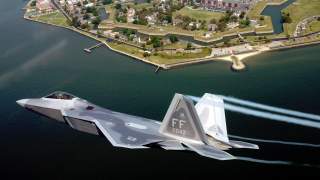Beware, North Korea: The Air Force is Preparing the F-22 for 'War'
New weapons and new software are coming.
The F-22 is known for a range of technologies including an ability called “super cruise” which enables the fighter to reach speeds of Mach 1.5 without needing to turn on its afterburners.
The fighter jet fires a 20mm cannon and has the ability to carry and fire all the air-to-air and air-to-ground weapons including precision-guided ground bombs, such Joint Direct Attack Munitions called the GBU 32 and GBU 39, service weapons developers explained. In the air-to-air configuration the Raptor carries six AIM-120 AMRAAMs and two AIM-9 Sidewinders.
It also uses what’s called a radar-warning receiver – a technology which uses an updateable database called “mission data files” to recognize a wide-range of enemy fighters, officials said.
Made by Lockheed Martin and Boeing, the F-22 uses two Pratt & Whitney F119-PW-100 turbofan engines with afterburners and two-dimensional thrust vectoring nozzles, an Air Force statement said. It is 16-feet tall, 62-feet long and weighs 43,340 pounds. Its maximum take-off weight is 83,500.
The aircraft was first introduced in December of 2005, and each plane costs $143 million, Air Force statements say.
The Air Force’s stealthy F-22 Raptor fighter jet delivered some of the first strikes in the U.S.-led attacks on the Islamic State in Iraq and Syria, when aerial bombing began in 2014, service officials told Scout Warrior.
After delivering some of the first strikes in the U.S. Coalition-led military action against ISIS, the F-22 began to shift its focus from an air-dominance mission to one more focused on supporting attacks on the ground.
Even though ISIS does not have sophisticated air defenses or fighter jets of their own to challenge the F-22, there are still impactful ways in which the F-22 continues to greatly help the ongoing attacks, service officials explained.
Image: Creative Commons/Flickr.

